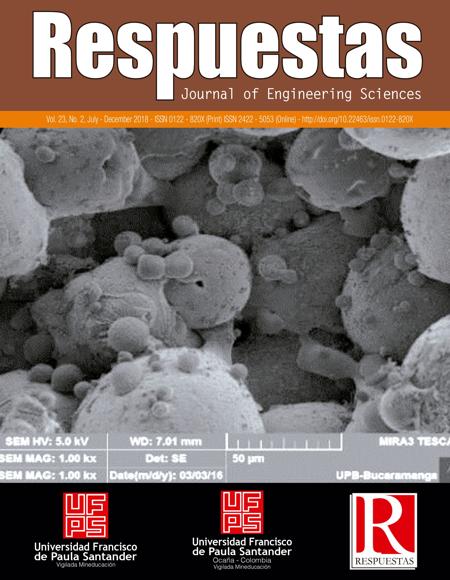Study of the carbon footprint in a ceramic production process in the metropolitan area of Cucuta
Estudio de la huella de carbón en un proceso productivo cerámico en el área metropolitana de Cúcuta
Main Article Content
The experimental process was proposed in order to establish the viability of substituting part of the mineral fraction used at present (clayey material) by residues of combustion processes (ashes) of coal in thermoelectric, as an element to reduce the carbon footprint of the process of production of ceramic products, without altering the quality, properties and functionality of the final product. The study focuses on the specific case of a brick-making company in the metropolitan area of Cúcuta, and on the substitution of 10% of the raw material (clay) for ashes from the thermoelectric plant, for the production of ceramic blocks. The analyses carried out establish an energy saving derived from the use of 10% fly ash equivalent to 997.12Kg of Norte de Santander coal per burn. The results determine that, in the case of brick production, the annual reduction of emissions associated with the production process, with the use of ashes from the thermoelectric, would be 849.48 tons of CO2. Thus, the carbon footprint is reduced by 16.39kgCO2equiv/t finished product, which represents a decrease of 5.99% of the carbon footprint compared to the conventional process.
Downloads
Article Details
N. L. Panwar, S. C. Kaushik y S. Kothari, «Role of renewable energy sources in environmental protection: A review» Renewable and Sustainable Energy Reviews, vol. 15, nº 3, pp. 1513-1524, 2011.
K. M. Zhang y Z. G. Wen, «Review and challenges of policies of environmental protection and sustainable development in China,» Journal of environmental management, vol. 88, nº 4, pp. 1249-1261, 2008.
A. Al-Fakih, B. S. Mohammed, M. S. Liew y E. Nikbakht, «Incorporation of waste materials in the manufacture of masonry bricks: An update revieW,» Journal of Building Engineering, vol. 21, pp. 37-54, 2019.
N. Wang, Z. Guo, F. Meng, H. Wang, J. Yin y Y. Liu, «The circular economy and carbon footprint: A systematic accounting for typical coal-fuelled power industrial parks,» Journal of cleaner production, vol. 229, pp. 1262-1273, 2019.
M. Lieder y A. Rashid, «Towards circular economy implementation: a comprehensive review in context of manufacturing industry,» Journal of Cleaner Production, vol. 115, nº 1, pp. 36-51, 2016.
S. Abbas, M. A. Saleem, S. M. S. Kazmi y M. J. Munir, «Production of sustainable clay bricks using waste fly ash: Mechanical and durability properties,» Journal of Building Engineering, vol. 14, pp. 7-14, 2017.
N. G. Kulkarni y A. B. Rao, «Carbon footprint of solid clay bricks fired in clamps of India,» Journal of cleaner production, vol. 135, pp. 1396-1406, 2016.
L. A. Lett, «Las amenazas globales, el reciclaje de residuos y el concepto de economía circular,» Revista Argentina de Microbilogía, vol. 46, nº 1, pp. 1-2, 2014.
I. S. Jawahir y R. Bradley, «Technological Elements of Circular Economy and the Principles of 6R-Based Closed-loop Material Flow in Sustainable Manufacturing,» Procedia CIRP, vol. 40, pp. 103-108, 2016.
M. D. Bovea, E. Diaz-Albo, A. Gallardo, F. J. Colomer y J. Serrano, «Environmental performance of ceramic tiles: Improvement proposals,» Materials & Design, vol. 31, nº 1, pp. 35-41, 2010.
J. Sánchez Molina, «Evaluación de los cambios en las propiedades térmicas y mecánicas del bloque #5 fabricado en la región, según las mezclas entre arcilla y residuos industriales,» Grupo de Investigación en Tecnologia Cerámica, UFPS, Cúcuta, Colombia, 2013.
British Standards Institution , «PAS 2050:2001. Specification for the assessment of the life cycle greenhouse gas emissions of goods and services,» BSI, London, 2011.
International Organization for Standardization, «Carbon footprint of products - Requirements and guidelines for quantification,» ISO, Geneva, Suiza, 2018.
J. Sánchez Molina, «Aplicaciones de los nutrientes tecnológicos en la industria cerámica del área metropolitana de Cúcuta,» Tesis Doctoral. Universidad de Jaén, Linares, España, 2018
Asociación Española de Normalización y Certificación, «Reglas de producto»
TBE PCR FOR CLAR CONSTRUCTION PRODUCTS, «Guidance document for developing an EPD. Tiles & Bricks Europe aisbl,» Tiles Bricks, 2014.
Instituto Colombiano de Normas Técnicas, «NTC 6033. Etiquetas ambientales tipo I. Sello ambiental Colombiano (SAC) Criterios ambientales para ladrillos y bloques de arcilla,» INCONTEC, Bogotá, 2013.
Normalización Española, «UNE EN 15804:2012. Sustainability of construction works - Environmental product declarations - Core rules for the product category of construction products,» Normalización Española, Madrid, 2012.







